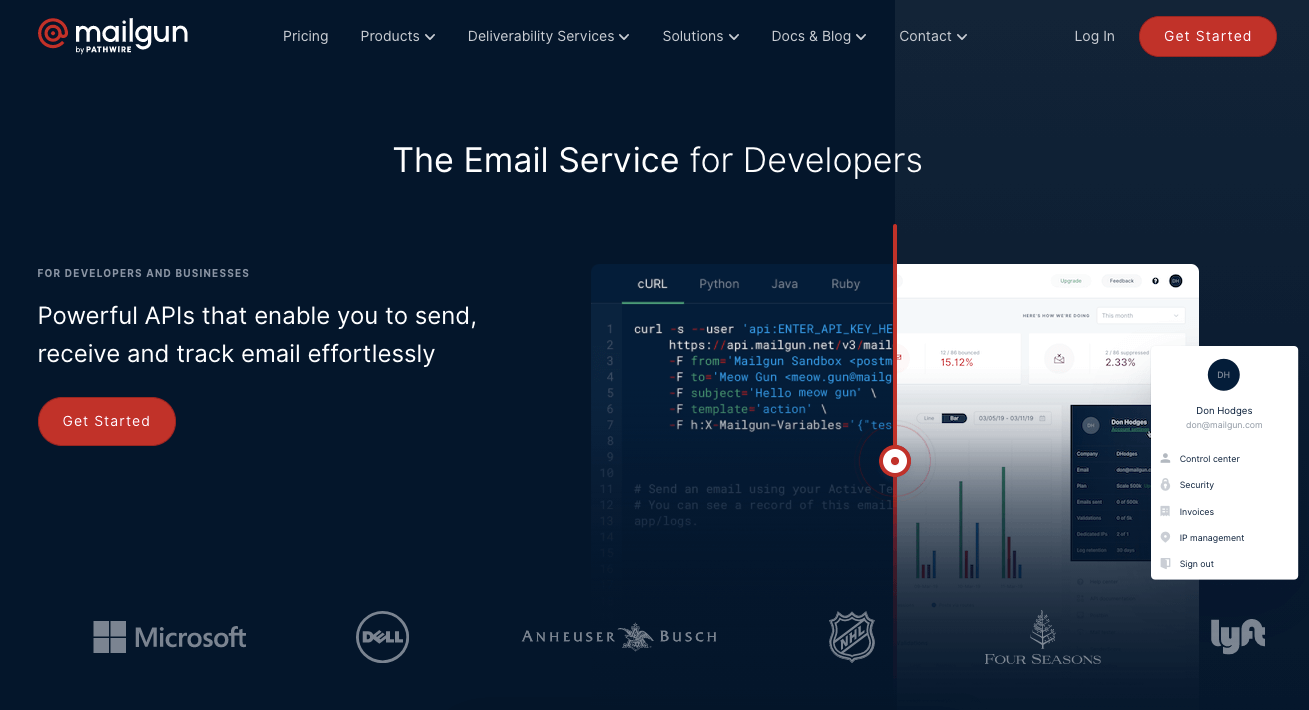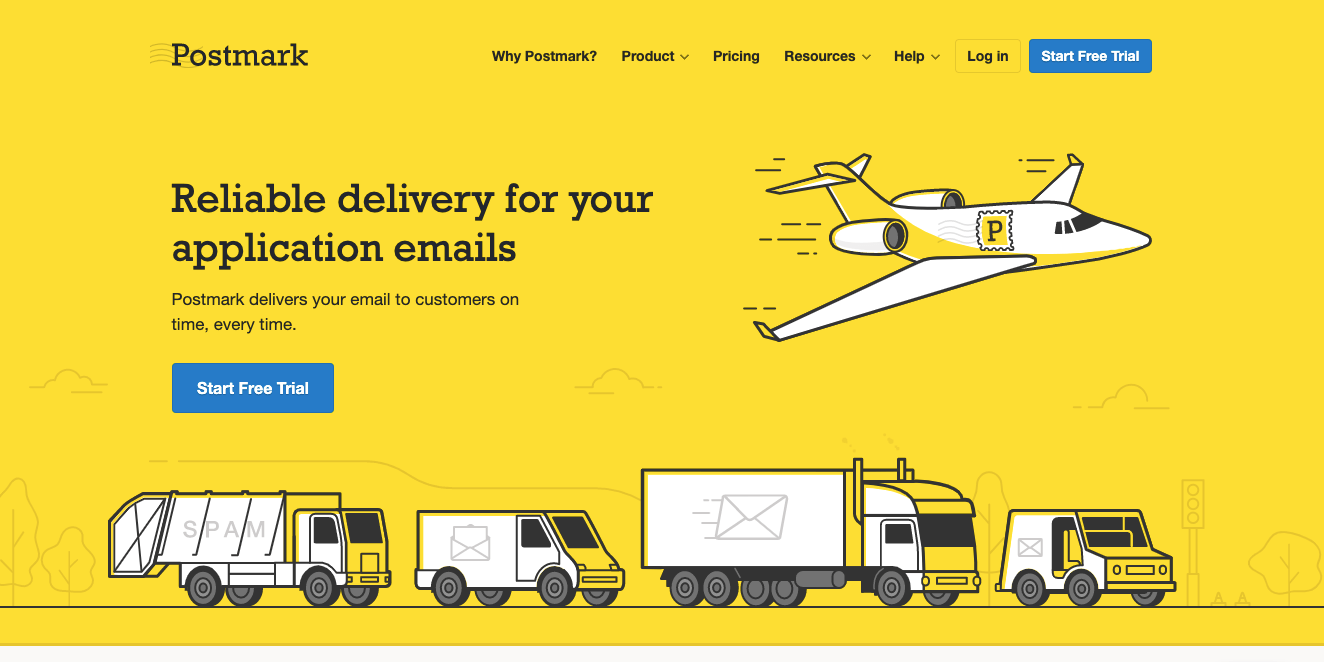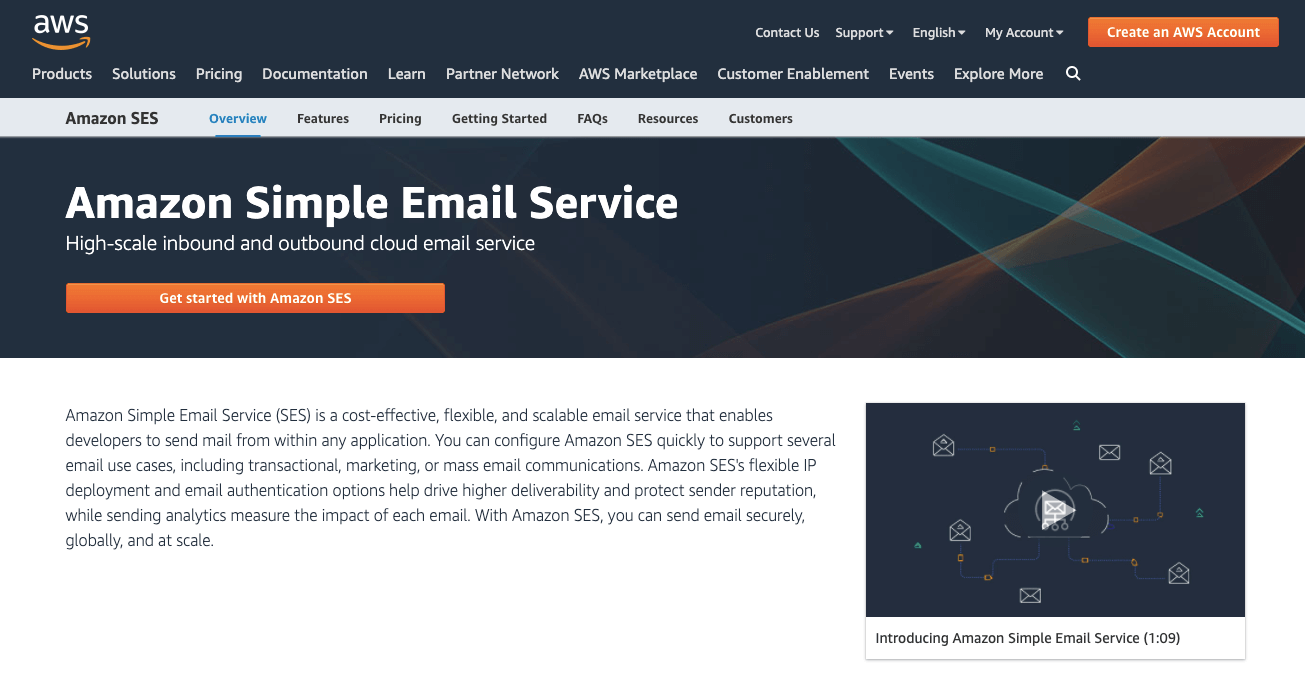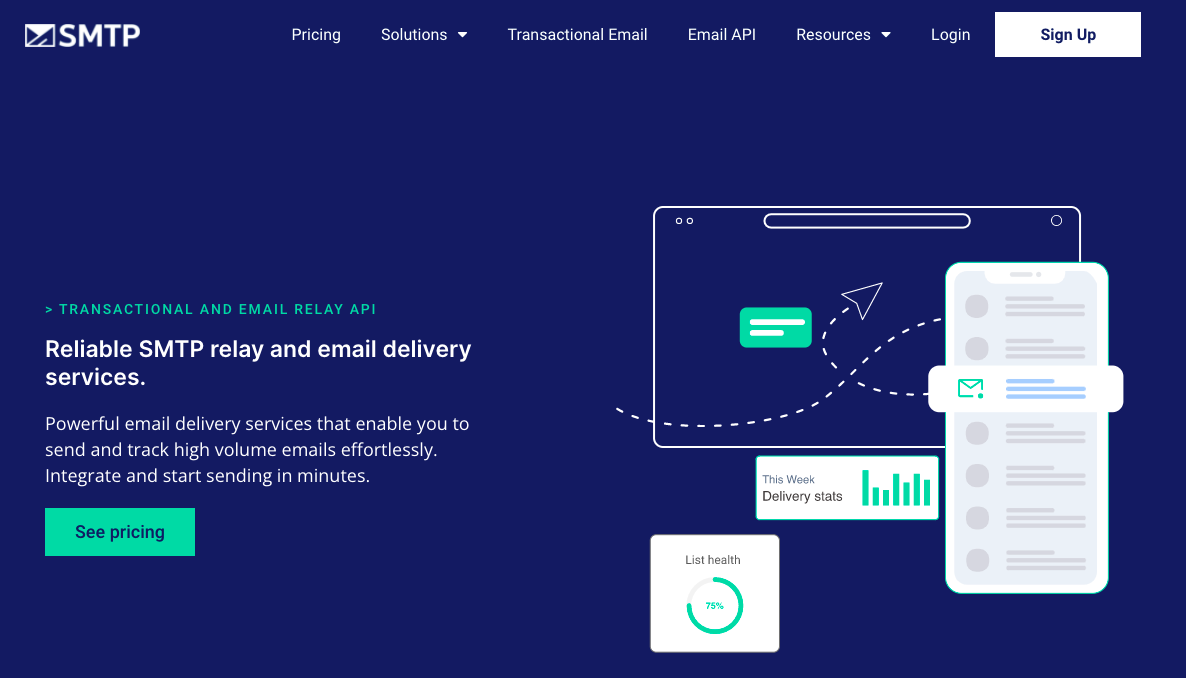What is an email api?
An email api gives your application access to an email sending platform without having to build it yourself. This is beneficial as many cloud hosting providers like AWS and Google Cloud do not allow you to run an email server.
You can send triggered emails directly within your application without having to write complex code and maintain email servers.
Why use an email api?
Despite email being an old technology, running an email server at scale is very complicated. It’s easier and more cost effective to consider an email API provider like Mailgun instead of building your own.
Email providers send billions of emails every month, have contacts at major inbox providers like Gmail and Yahoo, and have systems to keep spammers and other bad actors off their platforms. They’ve built up good reputations over the years which enables their clients to have good email deliverability.
Connecting to an email API is very easy. Once you register for an account they will generate API keys for you and provide documentation on how to pass data through. Many APIs can process hundreds of thousands of requests per second and are typically much more efficient than sending via SMTP servers.
What’s the difference between email API vs SMTP?
SMTP stands for Simple Mail Transfer Protocol and is one of the oldest ways of sending email. When sending via SMTP users need to consider what port to send from: 25, 465, 587. SMTP is only used for sending, receiving, and transfering email.
APIs on the other hand are interfaces that can accept many kinds of requests, not just email requests. APIs also allow developers to use their programming language of choice, be it Javascript, Python, or many others.
Sending over SMTP is most common when you don’t have direct access to add API calls to your application. An example of this is WordPress websites.
Many WordPress sites run on shared hosting servers which don’t allow API connections. So site owners use many of the SMTP WordPress plugins to send email instead.
If you host your own server and you have a developer to assist, APIs are always the better solution. APIs are more flexible, easier to customize, and can accept connections at a faster rate than SMTP servers.
Why do I know so much about email providers?
I worked at Mailgun for over two years so I got an inside look into how a large email provider operates. I wrote a longer Mailgun review if you want a more in-depth look.
However, I was not paid by Mailgun to write this review. I’m writing it several months after leaving the company on good terms.
I’m not in their affiliate program, I just wanted to use my inside knowledge to write an honest review of email API providers.
I lived and breathed email for over two years. I know a hell of a lot more than most bloggers do on this topic.
Don’t miss my guide on cc and bcc in email.
What is the best email api service?
- SMTP.com
- Mailgun by Sinch
- Postmark
- Twilio Sendgrid
- Sendinblue
- Amazon SES
Best Email API Services
Mailgun by Sinch

Have you ever received an email from the newsletter service Substack? Or received a ride receipt from Lyft?
Then you’ve actully received an email that was sent through Mailgun.
Mailgun processes over 20 billion emails each month but you may never know it. Mailgun, much like finance API Plaid, sends email behind the scenes without the end user being any wiser.
There’s nothing nefarious going on here, that’s just how email works.
Imagine you’re a company that needs to send billions of emails every month, like Pinterest. Your business, and your users, depends on those emails getting delivered to the inbox.
Sending billions of emails is super complicated, so you use a service like Mailgun instead.
Mailgun was founded and 2010 and graduated from Y Combinator. It was later acquired by Rackspace before spinning out on it’s own with funding from Turn/River capitol in 2017.
In April 2019 private equity behemoth ThomaBravo acquired a majority ownership in Mailgun. In October 2019 Mailgun acquired European email marketing company Mailjet. In February 2021 Mailgun announced a new corporate entity, Pathwire, that would combine the Mailgun and Mailjet brands under one umbrella.
Then In April 2021 Mailgun, now Mailgun by Pathwire, announced the acquisition of email testing tool Email on Acid.
In September 2021 Sinch, a European version of Twilio, announced they’re acquiring the entire Pathwire portfolio for about $2 billion.
Mailgun is and will continue to grow like crazy and they have the clients to prove it. Lyft, GitHub, Reddit, Substack, Patreon, and many others have all been Mailgun customers.
Yet many people still think Mailgun is an email service for small developers who only need to send a few thousand emails a month for their side project.
Mailgun is able to attempt delivery on 15 million emails an hour with a 99% guarantee. Does that sound like a small email provider to you?
Mailgun was the first 100% cloud email provider on the market. They don’t have any physical infrastructure, it’s all through Amazon AWS or Google Cloud. This is a huge benefit because they can scale up or down as necessary to support peak loads.
Sendgrid, Mailgun’s main competitor, still has physical servers. And their main sending pipeline is via SMTP, not via API like Mailguns, so Sendgrid has run into bottlenecks in the past.
One downside to Mailgun is their pricing. They offer a premium service and they’re priced like it, starting at $35/month for a plan that allows 50,000 emails sent per month. That’s a $0.70 cent CPM, or cost per thousand.
Mailgun is still incredibly cheap for the amount of emails you can send but $35/month can be a steep price to pay for someone just starting out with email.
Postmark

Postmark is Mailgun’s closest self-service competitor in the transactional email space.
For a long time Postmark only allowed transactional emails on their platform, which means things like password resets, receipts, or any email that was specifically requested by the user.
Why? Transactional emails are by nature different than marketing emails. Transactional emails have higher open rates because users are expecting them.
In contrast, marketing emails are emails sent with commercial intentions. They’re designed to make money and sell stuff.
Postmark made a decision to stay away from marketing emails until 2020 when they announced message streams.
What I like most about Postmark is they post their delivery times right on the homepage. It’s a transparent way of showing the performance of their email servers to a given inbox provider, like Gmail, Yahoo, Apple Mail, or AOL.
Postmark also has the lowest pricing out of any provider on this list. Starting at $10/month for 10,000 emails.
But Sendgrid allows 50,000 emails for $14.95, so Postmark isn’t the cheapest on a CPM basis. Their next plan is $50/month for 50,000 emails.
Postmark does have an industry leading log retention of 45 days. In comparison, Mailgun’s cheapest plan only supports 5 days of log retention, with a max of 30 days with their $90/month scale plan.
Now that Postmark allows marketing emails they’re a compelling choice for self-service users. Their Enterprise offering isn’t as mature as Mailgun or Sendgrid, so for companies sending millions of emails each month I would recommend looking elsewhere.
Twilio Sendgrid

Sendgrid was acquired by SMS giant Twilio in October 2018. Twilio would later go on to acquire customer data platform Segment in November 2020 for $3.2 billion.
Sendgrid is larger than Mailgun in terms of revenue, employee count, and monthly emails processed.
On Black Friday 2020 Sendgrid processed 5.8 billion emails, and on Cyber Monday they processed 5.7 billion emails.
That’s a huge, crazy, insane amount of emails. Sendgrid absolutely has the scale and expertise to backup that kind of sending volume, even if they had a serious compromised account problem in October 2020.
Sendgrid has some huge companies in it’s umbrella, including:
- Uber
- Spotify
- Airbnb
- Yelp
- Instacart
Sendgrid is also cheaper than Mailgun: their email API Essentials plan starts at $14.95 and includes 50,000 emails. Compared to Mailgun’s $35/month plan Sendgrid is $20 cheaper.
Both Mailgun and Sendgrid have free plans that included a limited amount of emails for 3 months, but it’s frankly not worth comparing them.
Free plans at any email provider are a hot bed for spammers and other bad actors, and email providers purposely neuter them as a form of deterrence.
Their free plans also have fairly poor support experiences too, for similar reasons. Many providers will have the best support times for their highest paying customers. Their lowest and $0 customers often have to wait longer, it’s a fact of life when you have hundreds of thousands of customers.
Sendinblue

Founded in 2007, Sendinblue is the only true venture capitol backed email API provider in this list. To date they’ve raised almost $200 million in funding and have acquired two companies, MailClark and Newsletter2Go.
Based in France, Sendinblue’s growth strategy is unique in the email space. They’re aggressively acquiring customers through paid media acquisition. They have a best-in-class affiliate program (of which I am a part of) and frankly have a really good email marketing tool.
Sendinblue is chasing Mailchimp’s customer base and offer many similar products and tools. Sendinblue is the only tool on this list to offer a landing page builder, Facebook retargeting, a CRM, and a chat bot.
Who do they think they are, Intercom?
In all seriousness, email API isn’t Sendinblue’s core product. Most SMBs don’t need an email API so it’s clearly not a core focus for Sendinblue.
Their documentation leaves much to be desired.
But Sendinblue’s strengths lie with email marketing, and that’s the core market they serve. So if you’re in the need for more robust email marketing tools, which neither Mailgun nor Postmark support, then Sendinblue is the right choice.
Amazon SES

Amazon SES is last on this list because frankly it’s the worst of the bunch.
At first look their pricing is attractive and they have the most generous free plan of any email provider: 62,000 emails/month.
Granted, that’s only if you also use SES from an EC2 instance, Amazon’s way of locking you into their ecosystem. But SES has a serious downside.
Absolutely zero support for people on the free plan. Even once you scale up and start paying Amazon, the SES support is horrendous.
I know because when I worked at Mailgun we’d get customers who told us they switched away from SES solely because of their support experiences.
I personally wouldn’t recommend SES to anyone, but if you’re a current Amazon AWS user who wants to send emails for free, SES might be for you.
SMTP.com

SMTP.com is a reliable SMTP-based relay and email delivery service. They’ve been in business for over 22 years, service over 100,000 businesses around the world, and have a 99.99% uptime.
Starting at $25, their Essential plan allows you to send 50,000 emails each month.
With that you get a shared IP address, their email relay API, and access to their support team of email experts in case you run into problems.
What makes SMTP.com stand out is their complete email deliverability suite, with tools like reputation defender, email list validation, and a managed delivery service, you get:
- Always-on proactive scanning to catch bounces before they happen
- A fast, safe, and reliable email list validation service to keep your email list clean
- Consulting from industry experts with decades of experience
SMTP.com sends billions of emails every month and is a great choice for high volume senders as well.
If you’re sending over 250 million emails a month then their Enterprise plan is worth looking at too.
Summary
Mailgun is my email provider of choice. They have a fantastic support team, are backed by serious private equity money, and support some of the largest brands on the planet.
My first hand experience with them makes Mailgun my unequivocal choice for best email API provider.
